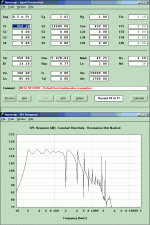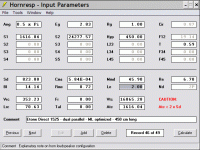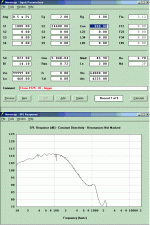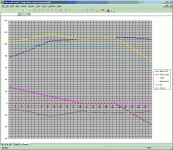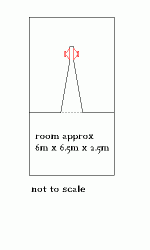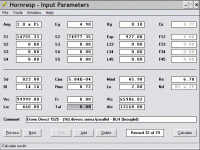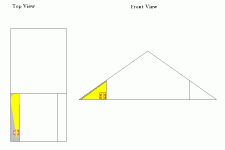Hi!
Currently thinking about large bass horns. Was looking at the LAB design but this would be cheaper and probably better for me as I don't need a small box...
I found an economical woofer made here in Australia by Etone:
Details + specs: http://www.etonesound.com/bass_drivers.htm#1525
I am not experienced with horns but have have put together a quick horn response model and would be interested in comments as to whether there is anything I have overlooked which is highly likely...
They don't publish the XMAX but assuming it it 3mm or so Hornresponse indicates the maximum output should still be > 125db @ > 20hz and an efficiency of > 110db/wm @ > 20hz.
That said I think XMAX is likely to be an issue with this design.
If the model is ok this could be a good sub, easy to build too as it is a conical design.
cheers, DB 🙂
Currently thinking about large bass horns. Was looking at the LAB design but this would be cheaper and probably better for me as I don't need a small box...
I found an economical woofer made here in Australia by Etone:
Details + specs: http://www.etonesound.com/bass_drivers.htm#1525
I am not experienced with horns but have have put together a quick horn response model and would be interested in comments as to whether there is anything I have overlooked which is highly likely...
They don't publish the XMAX but assuming it it 3mm or so Hornresponse indicates the maximum output should still be > 125db @ > 20hz and an efficiency of > 110db/wm @ > 20hz.
That said I think XMAX is likely to be an issue with this design.
If the model is ok this could be a good sub, easy to build too as it is a conical design.
cheers, DB 🙂
Attachments
Greets!
Well, I came up with a bit different specs based on a little more likely Sd, but they sim no differently, so at least we're on the same 'page' 😉:
Fs = 27 Hz
Vas = 564 L
BL = 14.1 N/A
Qms = 14
Qts = 0.33
Pe = 300 W
Pm = 600 W
Xmax = ?
Calc'd:
Re = 6.7 ohms
Qes = 0.338
Sd = 823 cm^2
eff = 97.02 dB/W/m
Fl = 4.56 Hz
Fh = 159.76 Hz
Anyway, simmed a 19.14 Hz using ML's math and while it was much flatter and much better damped, etc., it was ~4.757x larger than yours with the same 1 mm excursion/20 Hz, so it would be hard to justify the size/cost of such a 'beast' except for 'bragging' rights.
Maintaining the same motor box assembly, but shortening it until it's only ~3.08x larger yields negligible performance differences, so theoretically ~the best trade-off between size/performance, but probably still way too large.
Dropping it down to your's 450 cm length it's still smoother/better damped, though still a bit bigger at 3,866.848 L. Making it conical, it's bigger still even with your's small mouth and doesn't look any better overall, so given these choices FWIW I like the 450 cm length one.
As always YMMV, etc..
GM
Well, I came up with a bit different specs based on a little more likely Sd, but they sim no differently, so at least we're on the same 'page' 😉:
Fs = 27 Hz
Vas = 564 L
BL = 14.1 N/A
Qms = 14
Qts = 0.33
Pe = 300 W
Pm = 600 W
Xmax = ?
Calc'd:
Re = 6.7 ohms
Qes = 0.338
Sd = 823 cm^2
eff = 97.02 dB/W/m
Fl = 4.56 Hz
Fh = 159.76 Hz
Anyway, simmed a 19.14 Hz using ML's math and while it was much flatter and much better damped, etc., it was ~4.757x larger than yours with the same 1 mm excursion/20 Hz, so it would be hard to justify the size/cost of such a 'beast' except for 'bragging' rights.
Maintaining the same motor box assembly, but shortening it until it's only ~3.08x larger yields negligible performance differences, so theoretically ~the best trade-off between size/performance, but probably still way too large.
Dropping it down to your's 450 cm length it's still smoother/better damped, though still a bit bigger at 3,866.848 L. Making it conical, it's bigger still even with your's small mouth and doesn't look any better overall, so given these choices FWIW I like the 450 cm length one.
As always YMMV, etc..
GM
Attachments
Please look here, too.
Hi,
Although the tapped horn has become quite the darling of late, you can still see an excellent horn sub design using different Etone drivers. Go here Cowan Audio and click on "Horn Sub Jr." on the left hand side.
Bruce
Hi,
Although the tapped horn has become quite the darling of late, you can still see an excellent horn sub design using different Etone drivers. Go here Cowan Audio and click on "Horn Sub Jr." on the left hand side.
Bruce
GM said:Greets!
Re = 6.7 ohms
Qes = 0.338
Sd = 823 cm^2
eff = 97.02 dB/W/m
Fl = 4.56 Hz
Fh = 159.76 Hz
Anyway, simmed a 19.14 Hz using ML's math and while it was much flatter and much better damped, etc., it was ~4.757x larger than yours with the same 1 mm excursion/20 Hz, so it would be hard to justify the size/cost of such a 'beast' except for 'bragging' rights.
Maintaining the same motor box assembly, but shortening it until it's only ~3.08x larger yields negligible performance differences, so theoretically ~the best trade-off between size/performance, but probably still way too large.
Dropping it down to your's 450 cm length it's still smoother/better damped, though still a bit bigger at 3,866.848 L. Making it conical, it's bigger still even with your's small mouth and doesn't look any better overall, so given these choices FWIW I like the 450 cm length one.
As always YMMV, etc..
GM
Hi GM - Thanks for your reply !
Your model looks like a slight improvement in terms of the smoothness of response, but as you say it is a somewhat bigger mouth...
I'm not interested in bragging rights except for (cost/) performance! Happy to increase the size to the extent that performance in also increased.
I have been playing around with the model and came up with the attached. It is a bit longer at 8m but still about 1:1 compression and 14000cm2 (1.2meter square mouth - fits standard size sheets!) The biggest change is I removed the rear chamber and instead it will be an 'infinite baffle' arrangement, do you see any problems with this?. This results in a hugely extended bass response, in fact I can see the need for attenuating the very low bass to compensate for room gain... I can see Xmax being an issue, I think I read that the Etone drivers don't have much. I imagine a flat response to under 10hz (after room gain) would be great for movies! I admit that I am only working from theory here and really don't have any experience, so please tell me if you think it won't work...
Perhaps a 6db high pass filter would be required to compensate for room gain and stop the low stuff under 20hz from bottoming out the drivers? Or would I be better off just putting a rear box around the driver to achieve the same effect? (would go back to 450cm one as with this particular model, adding a box makes the response *extremely* ugly!
 )
)BTW Any idea what causes the little null at 110hz? Not that it matters as it is very narrow and out of the pass band.
cheers, DB 🙂
Attachments
Hi
Here is a in-room response I plotted from the 800cm horn model I just posted above. It takes the results from HornReponse and adds 9db/octave of room gain under 30hz (is that realistic?) and 24db/octave xover rolloff over 70hz. It also shows the required EQ to obtain a flat response.
Is there anything I have missed here?
cheers, DB
Here is a in-room response I plotted from the 800cm horn model I just posted above. It takes the results from HornReponse and adds 9db/octave of room gain under 30hz (is that realistic?) and 24db/octave xover rolloff over 70hz. It also shows the required EQ to obtain a flat response.
Is there anything I have missed here?
cheers, DB
Attachments
Re: Please look here, too.
Hi Bruce!
Have previously seen William's site, including that horn sub and it is all good stuff! That particular horn sub has a cutoff a bit higher than what I am looking for. I want to build something that can play low and loud with low distortion, so it will have to be big! There is otherwise unused empty space available so fortunately within reason size isn't really an issue for me.
cheers, DB 🙂
brucedal1 said:Hi,
Although the tapped horn has become quite the darling of late, you can still see an excellent horn sub design using different Etone drivers. Go here Cowan Audio and click on "Horn Sub Jr." on the left hand side.
Bruce
Hi Bruce!
Have previously seen William's site, including that horn sub and it is all good stuff! That particular horn sub has a cutoff a bit higher than what I am looking for. I want to build something that can play low and loud with low distortion, so it will have to be big! There is otherwise unused empty space available so fortunately within reason size isn't really an issue for me.
cheers, DB 🙂
Greets!
Yes, and a completely different motor design.
Actually, you didn't remove the rear chamber, just made it it very big, not the same by a long shot. You have to zero out Vrc/Lrc to sim a BLH and then use the 'combined response' tool in the SPL response window to see how the driver's response comb filters with the horn's to get some idea of what a 'messy' response you'll be getting with such a low Fc/wide BW horn.
Well, at this amount of horn gain, even one watt is about all you'll need, so as long as the driver has at least 3 mm Xmax it should be fine.
WRT room gain, don't gamble on this much down low unless the horn is to be located in a below grade concrete basement with no windows or doors as few homes are rigid/damped enough to handle infrasonic frequencies at the level this large a horn is capable of, though it will shake it pretty good as it dissipates all that acoustic energy.
Indeed, at this size you're really better off IMO either building a false wall IB of a similar Vb and load it with as many cheap, low Fs/~0.5 Qts drivers as it takes to get the efficiency up or a number of low tuned subs spaced around the room to mask all the room modes, both of which will handle any movie or music soundtrack, at lower distortion no less.
The notch is caused by a standing wave in the large rear chamber. Click 'yes' when it asks if you want these masked in the sim. This sims some stuffing in the rear chamber. That, or remove the rear chamber to make it a true BLH, then they will disappear.
GM
Yes, and a completely different motor design.
Actually, you didn't remove the rear chamber, just made it it very big, not the same by a long shot. You have to zero out Vrc/Lrc to sim a BLH and then use the 'combined response' tool in the SPL response window to see how the driver's response comb filters with the horn's to get some idea of what a 'messy' response you'll be getting with such a low Fc/wide BW horn.
Well, at this amount of horn gain, even one watt is about all you'll need, so as long as the driver has at least 3 mm Xmax it should be fine.
WRT room gain, don't gamble on this much down low unless the horn is to be located in a below grade concrete basement with no windows or doors as few homes are rigid/damped enough to handle infrasonic frequencies at the level this large a horn is capable of, though it will shake it pretty good as it dissipates all that acoustic energy.
Indeed, at this size you're really better off IMO either building a false wall IB of a similar Vb and load it with as many cheap, low Fs/~0.5 Qts drivers as it takes to get the efficiency up or a number of low tuned subs spaced around the room to mask all the room modes, both of which will handle any movie or music soundtrack, at lower distortion no less.
The notch is caused by a standing wave in the large rear chamber. Click 'yes' when it asks if you want these masked in the sim. This sims some stuffing in the rear chamber. That, or remove the rear chamber to make it a true BLH, then they will disappear.
GM
Hi!
With the last design, the drivers will actually be in a room that is bigger than the one the horn mouth is in, significantly bigger than the 100m3 horn response allows!
I have attached an image to illustrate this.
The construction is of solid timber frame and cement sheeting, with windows and doors... so point taken re room gain. Can I expect 15db under 30hz?
Re construction, would laminated mdf/paricle board/plywood be ok? it is just that it might end up being built using left over scraps all glued together. Personally I can't see any issue with using multiple different material types provided it is think/heavy enough and braced. I was thinking perhaps 5cm walls with bin braces on the inside and a lot of smaller ones on the outside?
Would the layout as indicated in the attached image with the horn mouth in the middle of the wall work ok? Will I end up exciting lots of room modes, and would two horns on opposite sides of the room help to avoid that?
I am inexperienced with horns, how literally can the horn response models be taken, i.e. if I make a certain model should I be surprised if in reality when built the horn performs differently?
many thanks, DB
With the last design, the drivers will actually be in a room that is bigger than the one the horn mouth is in, significantly bigger than the 100m3 horn response allows!
I have attached an image to illustrate this.
The construction is of solid timber frame and cement sheeting, with windows and doors... so point taken re room gain. Can I expect 15db under 30hz?
Re construction, would laminated mdf/paricle board/plywood be ok? it is just that it might end up being built using left over scraps all glued together. Personally I can't see any issue with using multiple different material types provided it is think/heavy enough and braced. I was thinking perhaps 5cm walls with bin braces on the inside and a lot of smaller ones on the outside?
Would the layout as indicated in the attached image with the horn mouth in the middle of the wall work ok? Will I end up exciting lots of room modes, and would two horns on opposite sides of the room help to avoid that?
I am inexperienced with horns, how literally can the horn response models be taken, i.e. if I make a certain model should I be surprised if in reality when built the horn performs differently?
many thanks, DB
Attachments
Greets!
Ah! OK.
'Perfect' room gain is 12 dB/octave below the 1st room mode and the only room that I've measured with it was an underground poured concrete basement with no windows and I'm not sure what windows other than what I've seen in military concrete bunkers that will contain high SPL without any loss.
Anyway, since the first room mode is ~26.5 Hz, the most you can hope for is ~10.89 dB/15 Hz.
Yes, you're right, thickness and bracing can make up for bonding different material scraps to form rigid/well damped walls, but don't know how thick they need to be, though I do know that a wall made with two 3/4" (3.81 cm) thick MDF sheets glued together makes a pretty good ~20 Hz diaphramatic absorber, so it will need to be considerably thicker than 5 cm IMO to get really low. For instance, in an interview, one ~15 Hz concrete bass-horn builder said that if he ever made another he'd use 6" thick instead of 4" thick walls, so this is what you're up against.
WRT to horn mouth layout and the room in general, it's a really poor acoustic environment, what with two dims being acoustically close together, so their modes will sum for the most part and this is compounded by the height modes combining from the 3rd harmonic onwards. Since you can't EQ a dip, you must attenuate the highs, so system efficiency
When only a single sub is used, there's no really good position other than a corner, but if a virtual line array is used, it's not too bad, so placing the horn dead center in both the horizontal and vertical planes and making its mouth width/height a sizeable percentage of the wall's width/height, then its mouth will appear acoustically 'infinite' due to reflections, so assuming a 6 m wide x 2.5 m wall the mouth needs to be at least 4.242 m W x 1.7675 m H, which area represents ~35.48 Hz. Plugging this mouth area into your BLH sim and using 1 pi space for the ~4.56 Hz flare frequency such a large rear chamber needs, it auto calcs a 6031.28 cm hyperbolic. Not too practical. Expo drops it 'only' to 2238.84 cm. Still too long. Conic needs some silly number, so not practical either.
Using Prof. Leach's math to try and smooth it helps, but length only drops to 2223.21 cm. 🙁 With this driver you're better off using a bunch of them to fill up the rear room's Vb and allow you to shorten the horn. With eight drivers it drops to 1350.01 cm and smoothes out quite a bit, but still too long. At sixteen drivers we're down to 927.08 cm and smoother still, but don't know if this is still too long.
Bottom line, for such a big, expensive horn it doesn't have much dynamic headroom, though its sub 10 Hz output will severely tax your room's construction.
GM
Ah! OK.
'Perfect' room gain is 12 dB/octave below the 1st room mode and the only room that I've measured with it was an underground poured concrete basement with no windows and I'm not sure what windows other than what I've seen in military concrete bunkers that will contain high SPL without any loss.
Anyway, since the first room mode is ~26.5 Hz, the most you can hope for is ~10.89 dB/15 Hz.
Yes, you're right, thickness and bracing can make up for bonding different material scraps to form rigid/well damped walls, but don't know how thick they need to be, though I do know that a wall made with two 3/4" (3.81 cm) thick MDF sheets glued together makes a pretty good ~20 Hz diaphramatic absorber, so it will need to be considerably thicker than 5 cm IMO to get really low. For instance, in an interview, one ~15 Hz concrete bass-horn builder said that if he ever made another he'd use 6" thick instead of 4" thick walls, so this is what you're up against.
WRT to horn mouth layout and the room in general, it's a really poor acoustic environment, what with two dims being acoustically close together, so their modes will sum for the most part and this is compounded by the height modes combining from the 3rd harmonic onwards. Since you can't EQ a dip, you must attenuate the highs, so system efficiency
When only a single sub is used, there's no really good position other than a corner, but if a virtual line array is used, it's not too bad, so placing the horn dead center in both the horizontal and vertical planes and making its mouth width/height a sizeable percentage of the wall's width/height, then its mouth will appear acoustically 'infinite' due to reflections, so assuming a 6 m wide x 2.5 m wall the mouth needs to be at least 4.242 m W x 1.7675 m H, which area represents ~35.48 Hz. Plugging this mouth area into your BLH sim and using 1 pi space for the ~4.56 Hz flare frequency such a large rear chamber needs, it auto calcs a 6031.28 cm hyperbolic. Not too practical. Expo drops it 'only' to 2238.84 cm. Still too long. Conic needs some silly number, so not practical either.
Using Prof. Leach's math to try and smooth it helps, but length only drops to 2223.21 cm. 🙁 With this driver you're better off using a bunch of them to fill up the rear room's Vb and allow you to shorten the horn. With eight drivers it drops to 1350.01 cm and smoothes out quite a bit, but still too long. At sixteen drivers we're down to 927.08 cm and smoother still, but don't know if this is still too long.
Bottom line, for such a big, expensive horn it doesn't have much dynamic headroom, though its sub 10 Hz output will severely tax your room's construction.
GM
Attachments
Hi!
Ok, I won't count on too much room gain then!
The alternate design you came up with is interesting, but not practical at all for my purposes, far too big and expensive! You have convinced me to go back to my original 4.5m conical design - I think 4.5m but not too wide will be alright ... Looks like I'll have to consider how much material is required to build it though!!!
I am not sure about concrete as it is an upstairs room, it might be a possibility as the building is solidly constructed, I'll have to check that. Concrete is probably more expensive too. To be honest I'm not going for world records, just good low bass with a plenty of headroom, at a reasonable price too! I guess an IB is a good alternative, getting suitable drivers here at a reasonable price is a problem though, and would be more expensive provided the horn doesn't cost too much. (We should be able to get most of the materials for free as scraps, packing sheets etc.)
How about making the walls quite thick (perhaps 15cm) but with lots of small cavities that get filled with expanding foam or fiberglass insulation?
Perhaps some planks of hardwood integrated into the laminated structure would help to prevent standing waves? There is some 2nd hand (50-100yr) old Tasmanian hardwood around that (for wood) is very rigid and dense.
The room layout may have been a bit misleading, it is in a roof space with a peak in the middle at 3.6m, with the side walls being only 1.5m high, so perhaps not quite as bad as it first appears?
Ok, so the best place is a corner, what do you think about the attached layout? The expansion will have to be a triangle shape but I suppose that is ok? Would it be better to use one in each corner?
I have attached an image to illustrate this.
Also, an interesting consequence of the sloped roof is that there will be a smooth transition of the horn mouth into the room, does this need to be added into the model and will it improve response?
BTW I spoke to ETone about the driver today and although I asked several times about the xmax, specifically referring to the excursion whilst the coil is still in the gap, the only answer I got was that the maximum excursion is > 15mm and that they haven't had any complaints and didn't think I would have any problems. Makes me suspect that the actual figure is embarrassingly low and their policy is not to publish it... I guess that is not really a problem for this application though and it is a cheap driver so I am happy to forgive it a relatively minor fault such as this provided it is otherwise good. They did say that the coil is about 20mm deep.
I do appreciate your comments!
cheers, DB
Ok, I won't count on too much room gain then!
The alternate design you came up with is interesting, but not practical at all for my purposes, far too big and expensive! You have convinced me to go back to my original 4.5m conical design - I think 4.5m but not too wide will be alright ... Looks like I'll have to consider how much material is required to build it though!!!
I am not sure about concrete as it is an upstairs room, it might be a possibility as the building is solidly constructed, I'll have to check that. Concrete is probably more expensive too. To be honest I'm not going for world records, just good low bass with a plenty of headroom, at a reasonable price too! I guess an IB is a good alternative, getting suitable drivers here at a reasonable price is a problem though, and would be more expensive provided the horn doesn't cost too much. (We should be able to get most of the materials for free as scraps, packing sheets etc.)
How about making the walls quite thick (perhaps 15cm) but with lots of small cavities that get filled with expanding foam or fiberglass insulation?
Perhaps some planks of hardwood integrated into the laminated structure would help to prevent standing waves? There is some 2nd hand (50-100yr) old Tasmanian hardwood around that (for wood) is very rigid and dense.
The room layout may have been a bit misleading, it is in a roof space with a peak in the middle at 3.6m, with the side walls being only 1.5m high, so perhaps not quite as bad as it first appears?
Ok, so the best place is a corner, what do you think about the attached layout? The expansion will have to be a triangle shape but I suppose that is ok? Would it be better to use one in each corner?
I have attached an image to illustrate this.
Also, an interesting consequence of the sloped roof is that there will be a smooth transition of the horn mouth into the room, does this need to be added into the model and will it improve response?
BTW I spoke to ETone about the driver today and although I asked several times about the xmax, specifically referring to the excursion whilst the coil is still in the gap, the only answer I got was that the maximum excursion is > 15mm and that they haven't had any complaints and didn't think I would have any problems. Makes me suspect that the actual figure is embarrassingly low and their policy is not to publish it... I guess that is not really a problem for this application though and it is a cheap driver so I am happy to forgive it a relatively minor fault such as this provided it is otherwise good. They did say that the coil is about 20mm deep.
I do appreciate your comments!
cheers, DB
Attachments
Greets!
You're welcome!
Eso's loft cement/stucco 30 Hz bass-horns: http://gallery.audioasylum.com/cgi/view.mpl?UserImages=2348
Anyway, forget concrete construction with an Fc in the teens. There's two ways to build a speaker cab, either mass it up until its Fs is below the speaker's pass-band or make it rigid enough to be above it. This way the driver/acoustic load can't make it resonate.
Obviously, to get a cab to resonate below say 10 Hz will have to be incredibly massive, but if its HF is rolled off by say, 150-200 Hz, then building it with well braced 19 mm void free plywood is doable. The problem with using plywood scraps is that they have to be void free ($$), otherwise it may creak/groan at various higher frequencies that can't be damped/EQ'd out and particleboard, MDF, etc., will push its Fs down which will require ever more lams until it's finally as dense/heavy as concrete.
From this we see that cavities filled with lightweight material isn't going to cut it in sub bass-horn construction.
The hardwood would be good for building the whole horn, but if there's not enough, then at least do the throat/initial expansion until it's gone, then transition to suitable scrap and whatever bracing is required to keep it from 'drumming'.
The sloped roof only helps with the room's higher harmonics. The main width/depth ones will still be there, though not as strong.
You can probably sim the room extension somewhat by breaking the horn down into sections, but you'll have no way to sim the room's finite Vb/reflections, so probably best to make a horn design that looks good in pi space and any improvement due to the room is a plus.
Well, it seems a shame to expend all this effort on rinky-dink drivers, but whatever works for you. 😉
GM
You're welcome!
Eso's loft cement/stucco 30 Hz bass-horns: http://gallery.audioasylum.com/cgi/view.mpl?UserImages=2348
Anyway, forget concrete construction with an Fc in the teens. There's two ways to build a speaker cab, either mass it up until its Fs is below the speaker's pass-band or make it rigid enough to be above it. This way the driver/acoustic load can't make it resonate.
Obviously, to get a cab to resonate below say 10 Hz will have to be incredibly massive, but if its HF is rolled off by say, 150-200 Hz, then building it with well braced 19 mm void free plywood is doable. The problem with using plywood scraps is that they have to be void free ($$), otherwise it may creak/groan at various higher frequencies that can't be damped/EQ'd out and particleboard, MDF, etc., will push its Fs down which will require ever more lams until it's finally as dense/heavy as concrete.
From this we see that cavities filled with lightweight material isn't going to cut it in sub bass-horn construction.
The hardwood would be good for building the whole horn, but if there's not enough, then at least do the throat/initial expansion until it's gone, then transition to suitable scrap and whatever bracing is required to keep it from 'drumming'.
The sloped roof only helps with the room's higher harmonics. The main width/depth ones will still be there, though not as strong.
You can probably sim the room extension somewhat by breaking the horn down into sections, but you'll have no way to sim the room's finite Vb/reflections, so probably best to make a horn design that looks good in pi space and any improvement due to the room is a plus.
Well, it seems a shame to expend all this effort on rinky-dink drivers, but whatever works for you. 😉
GM
Hello,
what do you think about a removeable bass horn system?
25-80 Hz 106 dB 1 W 1m, 1 sqm mouth.
my small big bass study
http://www.hm-moreart.de/100.htm
what do you think about a removeable bass horn system?
25-80 Hz 106 dB 1 W 1m, 1 sqm mouth.
my small big bass study
http://www.hm-moreart.de/100.htm
- Status
- Not open for further replies.
- Home
- Loudspeakers
- Subwoofers
- Economical large format bass-horn
